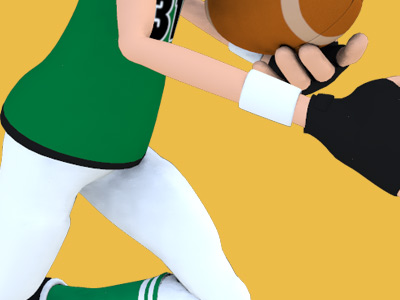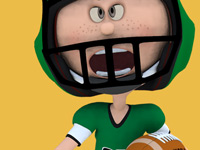American football

Screen pass (American Football Strategy)
A screen pass is a play in gridiron football consisting of a short pass to a receiver who is protected by a screen of blockers. During a screen pass, a number of things happen concurrently in order to fool the defense into thinking a long pass is being thrown, when in fact the pass is merely a short one, just beyond the defensive linemen. Screens are usually deployed against aggressive defenses that rush the passer. Because screens invite the defense to rush the quarterback, they are designed to leave fewer defensemen behind the rushers to stop the play.
Use
A screen pass can be effective, but it can also be risky as it is rather easy for a defensive player, even a lineman, to intercept the pass if a defender gets between the quarterback and the intended receiver. If the pass is intercepted, there are often few offensive players in front of the intercepting player, thus making it much easier for the intercepting team to earn a large return or to score a touchdown.
Types
Screens come in many forms. A screen to a running back to either the strong or short side of the field in the flats is often just called a screen. Screens to wide receivers come in four forms: the bubble screen, middle screen, slot screen, and slip screen.
The bubble screen was essentially created by Don Read when he was head coach of the Montana Grizzlies, and Lou Holtz, head coach of the Notre Dame Fighting Irish, brought the play into prominence after calling Read and asking for the play. The bubble screen involves a receiver taking a step forward, then darting toward the quarterback to receive the ball while the offensive linemen release to clear a path for the receiver. The benefit of the bubble screen is that it works against either zone or man-to-man coverage. A downside is that it is dependent on proper timing; a zone blitz or defensive end dropping into coverage can disrupt the timing, and may result in the quarterback being sacked.
The middle screen is similar to the bubble screen, except that the receiver continues his route to the middle of the field. The linemen release up the middle of the field in front of the receiver.
Shovel pass
A screen pass is sometimes executed using a shovel pass throwing motion. To throw a shovel pass the quarterback palms the football, and "shovels" the pass directly forward to the receiver, usually with a backhand, underhand or pushing motion. When a designed play calls for the quarterback to use a shovel pass forward to a receiver it is, by definition, also a screen pass. Because the pass appears to be a fumble if not completed, some defenses attempt to recover the ball as a turnover.
The Utah Pass is an overhand forward shovel pass of the ball. popularized by the Utah Utes football team. The play is commonly used by teams that use a spread offense.
Offensive action during a screen pass play
The quarterback drops back as if he is going to pass the ball deep. The offensive line sets up in pass protection for usually one to two seconds, then releases and lets the defensive line go. The player receiving the screen pass moves behind the releasing linemen and waits for the ball. The outside receivers run clear-out routes in order to make a path for the screen coming behind them.
If run properly, the defensive backs will be run out of the play by the receivers, and the defensive line will penetrate too far to stop the short pass from being thrown. The only defenders left will be linebackers, which will be picked up by the "screen" of offensive linemen in front of the receiver—hence the name "screen pass".
Types of plays
There are a number of variation on screen pass plays.
The "conventional" screen to the running back (the action described above). This type of play is something of a scripted checkdown.
A tight end screen where the tight end takes the place of the running back in the above description.
The wide receiver screen (or "jailbreak screen"), where the linemen sprint out in front of the wide receiver catching the screen pass. However, the blocking may be as simple as one receiver blocking ahead of another. A wide receiver screen thrown to a receiver moving towards the quarterback, behind one or more blocking receivers, is also commonly called a "tunnel screen".
The "quarterback throwback" screen, where the quarterback will pitch to a running back or throw a short pass to a wide receiver, and run the opposite direction, with releasing linemen in front of him. The running back or wideout will then lateral, or "throw it back" to the quarterback, with offensive linemen leading him downfield. This is also known as a "Blitz Beater" or "Blitz" for short because it's almost always used against a blitz-heavy defense, also called that because when you can tell a blitz is coming, this is a common play called to counter it, and the overpursuing nature of the blitz leaves the running back, and then the quarterback wide open with the possibility of gaining huge chunks of yardage. The "quarterback throwback" has been known to force defenses to blitz less, because one successful play can turn into a quick touchdown with a mobile quarterback.
The "middle screen", which has the same type of action as a "conventional" screen, but the linemen remain in the middle of the field rather than releasing to either side.
SPORTS



American Football
Game play in American football consists of a series of downs, individual plays of short duration, outside of which the ball is dead or not in play. These can be plays from scrimmage – passes, runs, punts, or field goal attempts (from either a place kick or a drop kick) – or free kicks such as kickoffs and fair catch kicks. Substitutions can be made between downs, which allows for a great deal of specialization as coaches choose the players best suited for each particular situation. During a play, each team should have no more than 11 players on the field, and each of them has specific tasks assigned for that specific play.
Rules and gameplay
- Scoring
- Maneuvers
- Strategy
- Play types
- Penalties
- Turnovers
- Downs
- Teams and positions
- Field
- Equipment
- Duration and time stoppages
- Advancing the ball and downs
- Kicking
- Officials and fouls
Positions
Offensive (Interior) line
Backs and receivers
Defensive line
Linebackers
Defensive backs
Special teams
- Kicker (K)
- Holder (H)
- Long snapper (LS)
- Punter (P)
- Kickoff specialist (KOS)
- Kick returner (KR) and Punt returner (PR)
- Upback
- Gunner
- Jammer


RESOURCES
This article uses material from the Wikipedia articles "American football", "American football rules", "Strategy", "Screen pass", which is released under the Creative Commons Attribution-Share-Alike License 3.0.
© Stories Preschool. All Rights Reserved.





